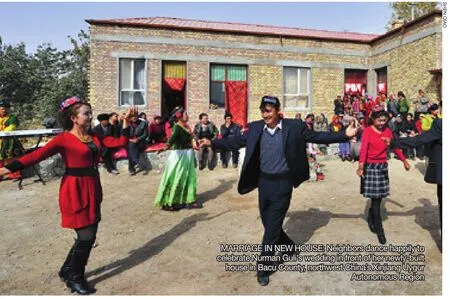Safe and Sound
2012-10-14ByYuanYuan
By Yuan Yuan
Safe and Sound
By Yuan Yuan
China is working to enhance the earthquake resistance of rural homes NaTIoN
O n October 21, Nurman Guli, a woman from Bacu County, northw est China’s X in jiang Uygur Autonomous Region, got married in her new house. Everyone in the neighborhood was invited to celebrate.
This is a community w ith rows of new ly built houses in Talaxiaor Village. A large project was launched in the region in 2004 to move rural residents from shantytowns to earthquake-resistant homes. The construction of this community was finished in 2011 and in early 2012 Guli and hundreds of other villagers moved into their new homes. So far,about 17,000 households in Bacu County have made the move.
The Xin jiang success
Xinjiang is prone to earthquakes. In the south of Xinjiang many rural residents lived in very simple shanties, which could not even withstand minor earthquakes.
In the past century, Xinjiang was struck by 104 earthquakes of magnitude 6 or above,including 14 tremors above magnitude 7 and two tremors above magnitude 8. In 2003,a magnitude-6.8 earthquake jolted Bacu County, killing 268 people and causing an economic loss of 1.37 billion yuan ($219 million). More than 80 percent of the loss came from housing damages.
In February 2004, the local government of Xinjiang decided to launch the project to build up seismic-resistant houses for rural residents,covering more than 1.2 million households in 49 counties and cities.
According to the project’s plan, new quake-resistant houses will be built each year for 300,000 households. The government of Xinjiang organized a team to check the quality of the houses to ensure their quakeresistance ability. Until 2009, the government had invested as many as 51.2 billion yuan($8.2 billion) to build anti-seism ic houses.

The new anti-seism ic houses sustained 33 earthquakes above magnitude 5 since 2004 and none of the houses collapsed in the earthquakes. On November 1, 2011, a magnitude-6 earthquake rocked the border area of Yining and Gongliu counties in south Xinjiang’s Ili Kazak Autonomous Prefecture but no casualties were reported and the damage was very lim ited. “This should be largely attributed to the housing renovation project,” said Chen Hong, Deputy Director of the Earthquake Emergency Management Department of the China Earthquake Administration.
Li Shum ing, a resident in Gongliu County, moved from north China’s Shanxi Province to Xinjiang 40 years ago. “I was 27 years old when I first moved here. Until 10 years ago, the village was pretty much the same as before,” Li said. “Things have been getting better in recent years.”
There are seven people in Li’s fam ily and they used to live in earth-walled houses for many years. “It is very uncom fortable. It was very cold in w inter and always leaked during rain. I think it m ight have fallen down even w ithout earthquakes,” Li said.
In 2010, know ing about the quake-resistant housing renovation project, Li applied for and received 5,000 yuan ($801) in subsidies to build a new house. “At the very beginning,only a few people in the village wanted to renovate their houses because every household had to foot part of the costs, but they didn’t want to spend,” Li said.
After Li’s new house was built, it became very popular among local villagers, especially when it rained as many other houses were leaking. Li once hosted more than 20 people in his house.
A fter the earthquake on November 1 last year, Li’s house remained standing and suffered no damage. Other villagers were not so lucky:their homes either suffered major cracks or collapsed. “They almost all swarmed to my house and rushed afterward to build their own quakeresistant houses,” Li said.
The governm ent then decided to build up a new community for the quakeaffected village and offered every household a subsidy of 45,000 yuan ($7,210). Li also moved into his new house. “It has a small courtyard and my son told me it is designed in a European style,” Li said.
The Yunnan lesson
Things in southwest China’s Yunnan Province appear to be different.
A 5.7-magnitude earthquake struck Yiliang County in Zhaotong City in Yunnan on September 7, killing 81 peop le. M ore than 6,600 houses collapsed and 122,000 were seriously damaged.
“Economic losses reached 3.51 billion yuan ($562 m illion),” said Su Jingyu, an official w ith the M inistry of Housing and U rban-Rural Development (MOHURD).
“W e blamed the earthquake and multiple aftershocks for the damage at fi rst. But it was later found the quake also ruined houses that were allegedly able to w ithstand magnitude-7 earthquakes.”
Su warned this problem does not only exist in Yiliang, but many other rural areas in the country. “The lack of seism ic consciousness is the main cause of this,” Su said.
In the 20th century, m ore than 800 earthquakes above magnitude 6 reportedly occurred in China, accounting for 30 percent of the world’s total. Since 1949, except for Zhejiang and Guizhou provinces, all provinces and regions on China’s mainland have been hit by earthquakes above magnitude 6.Almost all casualties resulted from housing damage.
In 1959, China released a draft standardizing seismic-resistant designs for houses. The 1959 standard was updated in 1964 and 1974,but was never enforced.

HOUSES IN DANGER: Rescuers tear down the remains of a home in Yiliang County, southwest China's Yunnan Province, after multip le earthquakes hit this area on September 7
A fter a 7.8-magnitude earthquake hit Tangshan in northern Hebei Province in July 1976 and killed more than 240,000 people,China released its first mandatory standard on seism ic design for industrial and civil buildings and put it into practice in 1978. Since then, new buildings in urban areas have been built according to the new standard and old houses are also reinforced accordingly. But rural areas are lagging, according to Ge Xueli,another official w ith the MOHURD.
A fter the Tangshan earthquake, each prefecture-level government on China’s mainland set up an earthquake emergency management office. But since the mid-1990s,the offices in most provinces and regions have closed down.
“Many people in rural areas build houses in an obsolete way, which leaves potential risks,” Ge said. “For exam p le, some residents in the east and south of China prefer cavity walls, which w ill suffer serious damage even in small earthquakes.The same is true of the earth-w alled houses in northwestern regions.”
“As earthquake forecasting is still unattainable w ith current technology, moving peop le into anti-seism ic houses is the best w ay to reduce casualties,” said Mao Yulin, Secretary General of Beijing-based Mao Yisheng Science and Technology Education Foundation.
Mao believes the experience of Xinjiang can spread to other parts of China.
On average, under current consumption standards,Mao said that the renovation subsidy for each recipient household can be set at 5,000 yuan ($794).
“Now we have approximately 800 m illion rural residents, roughly 200 m illion households, so the total investment can reach 1 trillion yuan ($160 billion),” Mao said. “The whole project may take about 10 to 20 years to complete, that is to say, every year the government needs to invest 50-100 billion yuan($8-16 billion). Compared to the 1.7 trillion yuan ($272 billion) the country put into reconstruction after the magnitude-8 Wenchuan earthquake hit Sichuan in May 2008, this is a small amount of money.”
Ge agrees w ith Mao, saying that many rural houses were not built up to standard and many houses function merely to block w ind and rain.
“We should put more effort into prevention to ensure the safety of residents. The huge losses from the Yiliang earthquake show we didn’t do a good job to begin w ith.”
